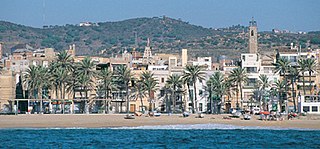
Badalona is a municipality in Barcelonès county, in Catalonia (Spain). It is located to the immediate north east of Barcelona, on the left bank of the Besòs River and on the Mediterranean Sea, in the Barcelona metropolitan area. By population, it is the third largest city in Catalonia and the twenty-third in Spain. It became a city in 1897.

Manresa is the capital of Bages county, located in the central region of Catalonia, Spain.

The Museu Nacional d'Art de Catalunya, abbreviated as MNAC, is a museum of Catalan visual art located in Barcelona, Catalonia, Spain. Situated on Montjuïc hill at the end of Avinguda de la Reina Maria Cristina, near Pl Espanya, the museum is especially notable for its outstanding collection of romanesque church paintings, and for Catalan art and design from the late 19th and early 20th centuries, including modernisme and noucentisme. The museum is housed in the Palau Nacional, a huge, Italian-style building dating to 1929. The Palau Nacional, which has housed the Museu d'Art de Catalunya since 1934, was declared a national museum in 1990 under the Museums Law passed by the Catalan Government. That same year, a thorough renovation process was launched to refurbish the site, based on plans drawn up by the architects Gae Aulenti and Enric Steegmann, who were later joined in the undertaking by Josep Benedito. The Oval Hall was reopened for the 1992 Summer Olympic Games, and the various collections were installed and opened over the period from 1995 to 2004. The Museu Nacional d'Art de Catalunya was officially inaugurated on 16 December 2004. It is one of the largest museums in Spain.
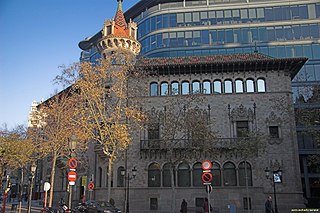
The Barcelona Provincial Council Local Museum Network, also known as Catalonia’s Biggest Museum, is a tool for support and collaboration from and for the museums of the province, which makes available to municipalities a series of services and actions aimed at improving, through the provision of direct services and research into viable formulas for supramunicipal cooperation, the management, conservation and dissemination of heritage and the museum facilities of the towns of Barcelona province. It is managed from the Cultural Heritage Office, which in turn depends on the Department of Knowledge and New Technologies of Barcelona Provincial Council.

The Mataró Museum is a museum in Mataró, in El Maresme, with a central office in Can Serra, a fortified Renaissance building dating back to 1565. The museum, which is part of the Barcelona Provincial Council Local Museum Network, also manages the different local heritage centres, such as:

The Montmeló Municipal Museum is a museum in the town of Montmeló, Catalonia, Spain. The museum is located in an old manor house, Can Caballé, which was built around 1920. In 1987, the town council bought the building and in 1996 approved its refurbishment as the home of the future museum, which opened in 1998. The Museum is part of the Barcelona Provincial Council Local Museum Network.
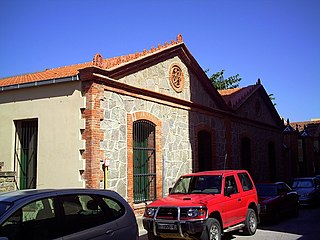
The Premià de Mar Printing Museum, located in the old gas factory of the town, is a museum dedicated to explaining the history of textile printing in Premià de Mar and all of Catalonia. It is part of Science and Technology Museum of Catalonia and the Barcelona Provincial Council Local Museum Network. Its main objective is to expose samples and objects related to textile printing and to explain the techniques used over time, as well as to highlight the important role that this economic activity has played in the past as a driver of industrialisation in Catalonia.
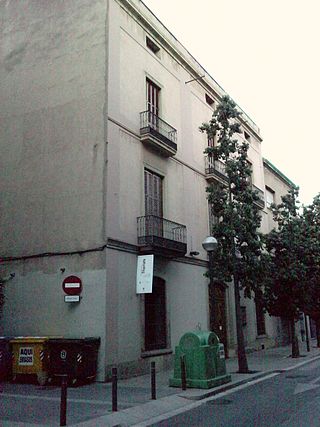
The Sabadell Art Museum or MAS is a museum specialised in Catalan painting from the 19th and 20th centuries and is located in Sabadell, the capital of El Vallès Occidental. It is part of the Barcelona Provincial Council Local Museum Network.
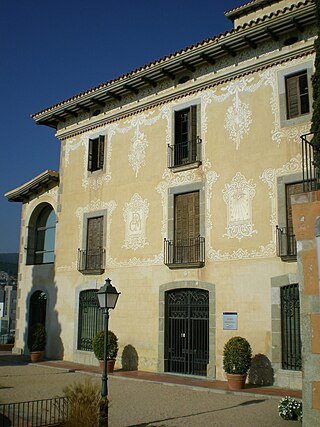
The Sant Andreu de Llavaneres Archive Museum, in Sant Andreu de Llavaneres (Maresme), is located in Can Caralt, an 18th-century farmhouse converted into a manor house in the second half of the 19th century. Can Caralt also houses the municipal archives.

The Sant Cugat Museum was opened on 23 April 2003; its mission was to oversee the conservation and dissemination of the historic, artistic and cultural heritage of Sant Cugat del Vallès in Catalonia. It is part of the Barcelona Provincial Council Local Museum Network and has two centres: the Sant Cugat Monastery and Casa Aymat plus two other buildings, the Celler Modernista and the Chapel of Sant Domenec. In both areas there are spaces reserved for temporary exhibitions related to art, history and local and universal heritage. In addition, the Museum works to recover the heritage and memory of the town, periodically organising walks that help people discover local history and heritage.
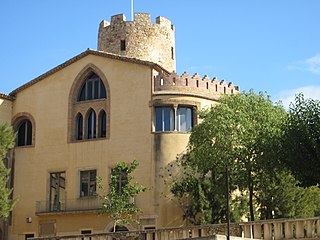
The Balldovina Tower Museum of Santa Coloma de Gramenet in Catalonia, Spain, is a local pluridisciplinary museum, the aim of which is to protect, conserve, study and disseminate the cultural and natural heritage of the territory. The museum, which is part of the Barcelona Provincial Council Local Museum Network, looks after its own collections as well as the monumental heritage of the town of Santa Coloma.

The Maricel Museum is a museum located in the centre of Sitges; reopened after a major refurbishment in 2015.
The Terrassa Museum is a museum entity which encompasses all the municipally owned museums in the city of Terrassa. It belongs to the History Museum and Monument Network of Catalonia and the Barcelona Provincial Council Local Museum Network.

The Southern apse from Pedret is a Romanesque fresco painting from late 11th century or the beginning of the 12th century, which was acquired during the 1919-1923 campaign of the Junta de Museus. The artwork originated from the southern apsidiole of the Church of Sant Quirze de Pedret and is currently exhibited in the Romanesque Art collection at the Museu Nacional d'Art de Catalunya, in Barcelona, Spain.

The Apse of Sant Climent de Taüll is a Romanesque fresco in the National Art Museum of Catalonia, Barcelona. The fresco is one of the masterpieces of the European Romanesque, from which the unknown Master of Taüll takes his name. It was painted in the early 12th century in the church of Sant Climent de Taüll in the Vall de Boí, Alta Ribagorça in the Catalan Pyrenees. The mural covered the apse of the church. In 1919-1923 it was moved, along with other parts of the fresco decoration, to Barcelona, in an attempt to preserve the murals in a stable, secure museum setting.
The Cave of Saint Ignatius is a sanctuary declared as a Local Cultural Heritage that includes a baroque church and a neoclassical building in Manresa (Catalonia), which was created to honor the place where, according to tradition, Saint Ignatius of Loyola shut himself in a cave to pray and do penance during his sojourn in the city from March 1522 to February 1523, where he wrote the Spiritual Exercises returning from his pilgrimage to Montserrat.
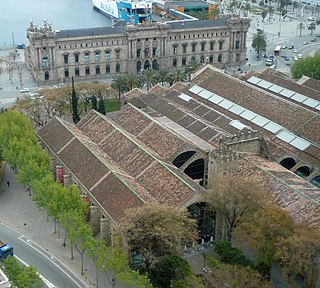
The Maritime Museum of Barcelona is located in the building of Drassanes Reials de Barcelona, the royal arsenal of Barcelona, dedicated to shipbuilding between the thirteenth century and eighteenth century. The first mention of these arsenals date from 1243 in a document indicating the boundaries of the city of Barcelona where it mentions its shipyard.

The Cork Museum of Palafrugell, Spain, is a museum about the cork industry in Catalonia. Founded in 1972, the Cork Museum is part of the Costa Brava Museum Network and the Network of Local Museums of Catalonia in Girona.

The Sant Feliu de Guíxols History Museum is located on the ground floor and in other plants of the Monestir de Sant Feliu de Guíxols, in the village of Sant Feliu de Guíxols, in the Baix Empordà region.

















